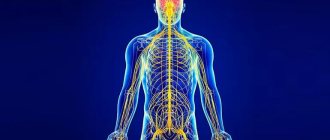Epilepsy occupies a special place among neurological diseases. It most often occurs in children, but can appear suddenly in adulthood. It is a chronic, incurable disease, but with effective treatment, attacks may become infrequent or disappear altogether. Patients with epilepsy need constant monitoring by their attending physician - a neurologist or epileptologist.
Symptoms and how an epilepsy attack occurs
The first symptoms of the disease appear between the ages of 5 and 15 years. The child begins to have a headache, loses sleep and appetite, and becomes irritable.
Suddenly the patient loses consciousness and falls sharply. After 15–20 seconds, the skin and mucous membranes acquire a bluish tint. Foam appears on the lips, convulsions occur, and the head is thrown back. Arms, legs and torso are stretched. After a few minutes the patient comes to his senses, but within 24 hours he feels very weak and needs rest. He doesn't remember anything about the attack. If he falls unsuccessfully, he may get injured, and then he will need the help of a surgeon.
There is a rare type of epilepsy in which the patient loses consciousness, but retains the ability to move. A good diagnosis is needed to confirm that it is epilepsy.
Symptoms
The main symptom of any form of epilepsy is seizures, during which the patient loses self-control and experiences memory loss.
In the symptomatic form, the symptoms depend on the location of the brain lesion that leads to such a disorder.
With pathologies in the frontal part of the patient, convulsions and seizures occur as often as possible, starting and ending spontaneously, and the duration of such seizures lasts less than a minute. Regular motor dysfunction is possible.
In the temporal form, in the absence of seizures, involuntary automatic movements of the facial muscles, hallucinations and alienation from reality are observed (the person at times may not understand what is happening to him and where he is).
The parietal form is characterized by:
- sudden increase in libido;
- spasmodic manifestations in various muscle groups throughout the body;
- sudden changes in body temperature.
The occipital form is characterized by the development of hallucinogenic syndrome and involuntary twitching and turning of the head, as well as abnormal activity of the facial muscular system.
Read about other types and forms of the disease in the articles:
- about Jackson's epilepsy, Rolandic and drug-resistant;
- about nocturnal, alcoholic and absence symptoms;
- about cryptogenic and idiopathic, partial and myoclonic.
Complications
Epilepsy is dangerous because it can cause a number of serious complications and even lead to the death of the patient.
Complications:
- Neurogenic pulmonary edema - due to improper functioning of the central nervous system, arterial hypertension occurs, which increases the load on the left atrium. This leads to pulmonary edema.
- Aspiration pneumonia—during a seizure, foreign bodies or vomit may enter the airways.
- Status epilepticus is a series of frequently recurring seizures. Sometimes the patient does not regain consciousness between attacks. Epistatus can lead to coma.
- Mental disorders: depression, irritability, rigidity of thinking, pickiness, resentment, aggressiveness.
- Death during a seizure.
To avoid complications, you must strictly follow your doctor’s prescriptions and undergo examination.
Episyndrome and epilepsy - what is the difference
It is necessary to differentiate true epilepsy from epileptic syndrome.
The main difference is in the origin of the pathology . Episyndrome always develops against the background of another brain disease.
Epilepsy is an independent disease that often occurs for unknown reasons.
With epilepsy, the patient experiences progressive mental disorders: psychosis, amnesia. Such patients are characterized by personality changes, expressed in decreased intelligence, impaired thinking, and changes in mood. With ES this practically does not happen.
Children with epilepsy experience hyperactivity or lethargy, increased aggression, and sadistic manifestations. These children cannot study in a regular school.
With episyndrome, the above manifestations are absent, children can attend educational institutions along with healthy peers.
If the underlying brain disease, which is the root cause of the development of ES, is eliminated, all signs will disappear. In other words, SE does not mean that the patient has epilepsy.
Find out more about epilepsy:
- forms and stages of the disease, its symptoms and signs, diagnostic methods;
- the patient’s lifestyle and menu, the ability to become pregnant and give birth if this disease is present;
- common consequences of the disease, preventive measures.
Causes of the disease
All the causes of epilepsy are still not clear. One of the most common causes of epilepsy in children is birth trauma or intrauterine hypoxia. Epilepsy often accompanies cerebral palsy.
Causes of epilepsy in adults:
- traumatic brain injuries;
- brain tumor;
- genetic brain diseases;
- infectious diseases (encephalitis, meningitis, etc.);
- cerebral hemorrhage;
- intoxication with chemicals or alcohol;
- brain abscesses;
- circulatory disorders in the vessels of the brain.
A variety of factors can provoke an epileptic attack, so the patient should avoid them:
- stress;
- flickering light;
- noise;
- overwork;
- sudden change in climate or weather.
About half of sick adults suffer from an idiopathic form of epilepsy, in which it is impossible to determine the true cause of the disease.
At risk are close relatives of patients with epilepsy, as well as patients who have suffered a stroke, traumatic brain injury or inflammatory diseases of the brain.
Idiopathic type
The trigger for the development of the idiopathic type of the disease is a genetic error in the transmission of nerve impulses.
The brain structures responsible for “quenching” nerve impulses do not work or work weakly, so the neurons are constantly excited.
If close relatives are diagnosed with the disease, then the likelihood of its occurrence in the child increases to 50%.
However, VE also manifests itself in those children whose parents are completely healthy. Neurodevelopmental disorders can be caused by the following factors:
- maternal illnesses during pregnancy (rubella, toxoplasmosis, herpes, etc.);
- a pregnant woman's use of alcohol or drugs;
- fetal hypoxia;
- trauma during childbirth.
Typically, the first attacks occur in children under 3 years of age or during puberty. Pathology manifests itself in various types of seizures:
- generalized attacks with convulsions, loss of consciousness;
- absence seizures (freezing in one place, fixing the gaze at a certain point);
- repeated chaotic movements;
- mental disorders (hallucinations, delusions, neuroses);
- contractions of one muscle group.
The difficulty is that the baby’s parents do not immediately notice the first symptoms, which allows the disease to progress.
The disease can be diagnosed using instrumental methods:
- electroencephalography;
- Ultrasound of the brain;
- Magnetic resonance imaging.
With VE, a focus of excitation is detected on the EEG, and increased neuronal activity is recorded. Treatment of a congenital disease involves long-term use of anticonvulsants.
They allow you to achieve stable remission, in which attacks do not recur for several years. The type of medication and dosage regimen are determined by the doctor depending on the type of illness.
The prognosis of the pathology depends on several factors:
- age of onset of disease;
- the presence of concomitant diseases (chromosomal pathologies, endocrine disorders);
- type of attacks and severity of the disease.
From the point of view of recovery, the most unfavorable disease is considered to be one with an early onset (before 3 years), generalized seizures, accompanied by other pathologies of the nervous system.
This type is malignant; children usually experience deviations in mental development. Patients are registered with epileptologists and have indications for assignment to a disability group.
They are forced to take anticonvulsants for the rest of their lives. Surgical treatment of epilepsy is also used.
Benign types of pathology have a more favorable prognosis.
These include:
- Rolandic epilepsy;
- epilepsy of sleep, reading;
- newborn seizures.
Often the disease disappears by adolescence, when the brain structures reach their maturity.
Diagnostics
The attending physician begins making a diagnosis by collecting anamnesis and questioning the patient’s relatives. Need to know:
- when did the first seizure occur?
- personal feelings of the patient during an attack;
- whether seizures occur regularly;
- what were the muscle spasms?
The patient's relatives will tell you what the seizure looked like, and the doctor will be able to get an idea of the disease and even find out in which part of the brain the epilepsy focus is located.
After this, an electroencephalogram is performed, which will accurately determine the epiactivity, focus and all signs of the disease. An EEG taken during a seizure will provide additional information.
If a patient is at high risk of epilepsy and feels weakness in the legs and arms, headaches, and lack of coordination, he may undergo an MRI of the brain.
Once the diagnosis is made, the doctor prescribes medications that reduce the frequency of seizures. These medications must be taken for life and checked regularly. If the cause of the disease is injury or tumor, the patient undergoes surgery. In case of severe epilepsy, the patient may be assigned a disability group.
Treatment
Treatment is etiotropic. Aimed at eliminating the root cause of the violation. In parallel, medications are used for the symptomatic treatment of epilepsy, that is, to relieve symptoms and prevent relapses.
Brain tumors are treated strictly surgically. The goal is total excision of neoplasia, that is, complete removal. If necessary, courses of chemotherapy and radiation therapy are prescribed. Many neoplasms have a good chance of complete recovery without the possibility of relapse. Not counting tumors of malignancy class 3 and higher.
Neuroinfections in the acute phase are treated with antibiotics (if they are of bacterial origin). The use of mild diuretics (Veroshpiron, Spironolactone) and glucocorticoids (Dexamethasone, Prednisolone) is mandatory. Infections that have already passed and left a mark do not require treatment. It is also impossible to eliminate organic disorders. Therapy is aimed at eliminating symptoms.
Cerebrovascular insufficiency is relieved with nootropics (Glycine), cerebrovascular drugs (Piracetam, Actovegin). Antihypertensive drugs (ACE inhibitors, beta blockers, calcium antagonists, etc.) are used as necessary.
Symptomatic treatment of epilepsy is carried out with carbamazepines (Carbamazepine and its analogues), valproic acid derivatives (valproates), and phenobarbital preparations are additionally used (as a means to “quench” excessive electrical signals). Specific names and dosages are selected by a neurologist after an in-person appointment. You cannot use this kind of means on your own. They are extremely severe, have a lot of side effects, and can provoke the opposite effect, lethal or disabling consequences.
First aid
A patient with epilepsy should be turned on his side. Do not put any foreign objects into the patient's mouth. A common misconception is that the patient's tongue can block the airway. This is not so: during an attack, all muscles come into motion, including the tongue, which is also a muscle. The tongue will not block the airway, but putting a spoon or other hard objects into the patient’s mouth can damage his teeth. If the patient has not regained consciousness 5 minutes after the onset of the seizure, it is necessary to urgently call an ambulance.
Epilepsy requires qualified treatment and constant medical supervision. The disease imposes some restrictions on life, for example, epileptics cannot drive or work in dangerous places. Nevertheless, with a favorable course and timely treatment, this disease allows you to lead a completely full life.
Kozhevnikov syndrome
Another type of symptomatic form is Kozhevnikov epilepsy, which is a mild symptom of the underlying disease - tick-borne encephalitis. With this disease, the patient does not develop characteristic epileptic seizures of a generalized form; everything is limited only to focal seizures.
This is what bilateral tonic-clonic seizures look like
The patient is fully conscious during the attacks, but cannot control his behavior, since the spasm that forms in him cannot be controlled.
The patient may feel muscle contractions on one of the arms or part of the body, usually opposite the lesion. Plus, in addition to the main symptoms of the disease, a generalized form of the disease may develop, when the whole body is involved in the process of convulsive contractions, however, this is the exception rather than the rule; such cases are quite rare.
Kozhevnikov syndrome can develop in both adults and children, since the infected tick does not care who it bites.
This syndrome can be prevented, for which you should immediately go to the clinic after the bite
Prevention
Let's list the preventive measures. Firstly, the constant use of anti-consultants. Secondly, maintaining a sleep schedule. Thirdly, you should not drink alcohol. If the EEG shows a high level of photosensitivity, you need to watch less TV and work at the computer, and you should not wear sunglasses. Prevention of stress and nervous overload.
Symptomatic or secondary epilepsy is considered a form of chronic disorder and is characterized by the occurrence of a variety of seizures. The disease can manifest itself against the background or after damage to brain structures, with problems with metabolism in neurons.









